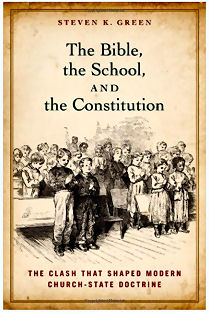
|
Posted February 9, 2012
Book: The Bible, the School, and the Constitution: The Clash that Shaped Modern Church-State Doctrine Author: Steven K. Green Oxford University Press. New York. 2012. pp. 289 An Excerpt from the Jacket:
An Excerpt from the Book: Despite the ongoing public controversy over Bible reading and prayer in the nation’s public schools, the Supreme Court has not waivered from its holdings in McCollum, Engel, and Schempp that school directed or promoted religious exercises violate the Establishment Clause. In later rulings the justices struck down ‘moments of silence’ for prayer, prayers at graduation ceremonies, the teaching of creationism and the posting of the Ten Commandments in public school classrooms. As recently as 2000 the Court turned aside a practice of student-led prayers at athletic events. With the issue of public funding of religious schools, the Court’s later holdings have been less consistent, reflecting the mixed ruling in Everson which identified separation and neutrality as complementary, if not competing, principles. Throughout the 1970s and the 1980s the Court struck down most funding programs, but in the mid 1980s the justices began to distinguish between direct and indirect funding mechanisms, the latter represented by tuition vouchers. In 2002, a divided Court upheld the use of vouchers for children attending religious schools. Within the ongoing debate over the public funding of religious education, the legacy of the School Question remains dominant. Modern church-state doctrine, regardless of its evolution in recent years, reflects the commanding impact of the events of the nineteenth century. The constitutional rationales for secular public schooling and a broader understanding of separation of church and state came together during that crucial period. During that time, non-sectarianism, which had developed as a means to preserve the Protestant character of public education and teach a common religious devotion, was transformed into a shell of its original self. That transition did not happen suddenly, but incrementally, as educators, clergy, and jurists struggled to reconcile the evolving goals of public schooling with a growing religious pluralism and emergent constitutional principles. It was the transformative era in America church-state law, the one in which America ceased to be a Republic of the Bible. Table of Contents: The rise of nonsectarian public education The development of the “no-funding principle” The Cincinnati “Bible War” of 1869-1873 “The Amendmentists” The Blaine Amendment The legacy of the school question |
|
